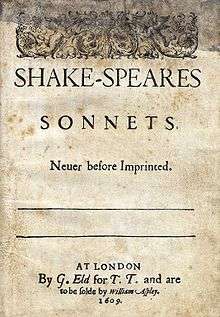Sonnet 5
| Sonnet 5 | |||||||
|---|---|---|---|---|---|---|---|
 The first three lines of Sonnet 5 in the 1609 Quarto | |||||||
|
| |||||||
| |||||||
Sonnet 5 is one of 154 sonnets written by the English playwright and poet William Shakespeare. It is a procreation sonnet within the Fair Youth sequence. It forms a diptych with Sonnet 6, which continues it.
Structure
Sonnet 5 is an English or Shakespearean sonnet. English sonnets consist of three quatrains followed by a couplet. This sonnet follows the form's typical rhyme scheme, abab cdcd efef gg. The first line is regular, but contains a syllabic expansion: "hours" is to be read as two syllables, a reading which is clearer in the Quarto's spelling, "howers". Lines eight, eleven, and fourteen contain initial reversals, a frequent variation in iambic pentameter.
× / × / × / × / × / Those hours that with gentle work did frame (5.1) / × × / × / × / × / Beauty's effect with beauty were bereft. (5.11)
- / = ictus, a metrically strong syllabic position. × = nonictus.
Analysis
It repeats the emphasis on human aging, compared with progress of the seasons. The “howers,” with which Sonnet 5, the first of a pair of sonnets, opens are the classical ‘Hours,’ the Horae or ‘Ωραι, daughters of Zeus and Themis, who presided over the seasons – hora can also mean ‘season’ – and their products were thought to engender ripeness in nature and the prime of human life. But the hours, which created his look, will in time act as destructive tyrants and make “vnfaire” that which in its fairness excels.[2]
The final couplet about "distilled flowers" refers to the extraction of perfume from petals, in which the visible "show" of the flowers disappears, but their "essence" remains. The same distillatory trope recurs in Sonnet 54, Sonnet 74 and Sonnet 119.[2] The reference is probably to the Youth's "seed" - his capacity to prolong his "essence" by producing children, but it is also an example of Shakespeare's play on the question of what is transient and what eternal in the material world.
References
- ↑ Pooler, C[harles] Knox, ed. (1918). The Works of Shakespeare: Sonnets. The Arden Shakespeare [1st series]. London: Methuen & Company. OCLC 4770201.
- 1 2 Larsen, Kenneth J. "Sonnet 5". Essays on Shakespeare's Sonnets. Retrieved 18 November 2014.
Further reading
- Baldwin, T. W. On the Literary Genetics of Shakspeare's Sonnets. Urbana: University of Illinois Press, 1950.
- Hubler, Edwin. The Sense of Shakespeare's Sonnets. Princeton: Princeton University Press, 1952.
- First edition and facsimile
- Shakespeare, William (1609). Shake-speares Sonnets: Never Before Imprinted. London: Thomas Thorpe.
- Lee, Sidney, ed. (1905). Shakespeares Sonnets: Being a reproduction in facsimile of the first edition. Oxford: Clarendon Press. OCLC 458829162.
- Variorum editions
- Alden, Raymond Macdonald, ed. (1916). The Sonnets of Shakespeare. Boston: Houghton Mifflin Company. OCLC 234756.
- Rollins, Hyder Edward, ed. (1944). A New Variorum Edition of Shakespeare: The Sonnets [2 Volumes]. Philadelphia: J. B. Lippincott & Co. OCLC 6028485.
- Modern critical editions
- Atkins, Carl D., ed. (2007). Shakespeare's Sonnets: With Three Hundred Years of Commentary. Madison: Fairleigh Dickinson University Press. ISBN 978-0-8386-4163-7. OCLC 86090499.
- Booth, Stephen, ed. (2000) [1st ed. 1977]. Shakespeare's Sonnets (Rev. ed.). New Haven: Yale Nota Bene. ISBN 0-300-01959-9. OCLC 2968040.
- Burrow, Colin, ed. (2002). The Complete Sonnets and Poems. The Oxford Shakespeare. Oxford: Oxford University Press. ISBN 978-0192819338. OCLC 48532938.
- Duncan-Jones, Katherine, ed. (2010) [1st ed. 1997]. Shakespeare's Sonnets. The Arden Shakespeare, Third Series (Rev. ed.). London: Bloomsbury. ISBN 978-1-4080-1797-5. OCLC 755065951.
- Evans, G. Blakemore, ed. (1996). The Sonnets. The New Cambridge Shakespeare. Cambridge: Cambridge University Press. ISBN 978-0521294034. OCLC 32272082.
- Kerrigan, John, ed. (1995) [1st ed. 1986]. The Sonnets ; and, A Lover's Complaint. New Penguin Shakespeare (Rev. ed.). Penguin Books. ISBN 0-14-070732-8. OCLC 15018446.
- Mowat, Barbara A.; Werstine, Paul, eds. (2006). Shakespeare's Sonnets & Poems. Folger Shakespeare Library. New York: Washington Square Press. ISBN 978-0743273282. OCLC 64594469.
- Orgel, Stephen, ed. (2001). The Sonnets. The Pelican Shakespeare (Rev. ed.). New York: Penguin Books. ISBN 978-0140714531. OCLC 46683809.
- Vendler, Helen, ed. (1997). The Art of Shakespeare's Sonnets. Cambridge, MA: The Belknap Press of Harvard University Press. ISBN 0-674-63712-7. OCLC 36806589.
External links
 Works related to Sonnet 5 (Shakespeare) at Wikisource
Works related to Sonnet 5 (Shakespeare) at Wikisource- An analysis and paraphrase of the sonnet
- Shakespeare sonnets.com on Sonnet 5
.png)
